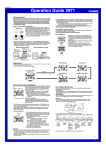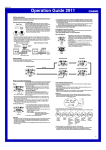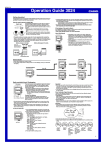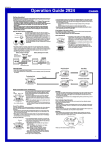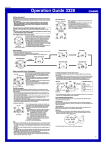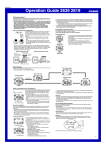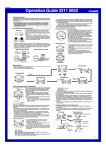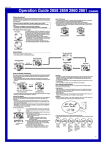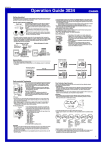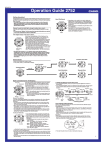Download Casio 2628 Watch User Manual
Transcript
MO0608-EA Operation Guide 2628 Getting Acquainted Congratulations upon your selection of this CASIO watch. To get the most out of your purchase, be sure to read this manual carefully. • This watch does not have a time zone that corresponds to the Greenwich Mean Time differential of –3.5 hours. Because of this, the radio-controlled timekeeping and World Time functions will not display the correct time for Newfoundland, Canada. Keep the watch exposed to bright light l l l l l l l l l l l Bright Light Solar cell The electricity generated by the solar cell of the watch is stored by a built-in battery. Leaving or using the watch where it is not exposed to light causes the battery to run down. Make sure the watch is exposed to light as much as possible. • When you are not wearing the watch on your wrist, position the face so it is pointed at a source of bright light. • You should try to keep the watch outside of your sleeve as much as possible. Charging is reduced significantly if the face is only partially covered. • The actual level at which some functions are disabled depends on the watch model. • Frequent display illumination can run down the battery quickly and require charging. The following guidelines give an idea of the charging time required to recover from a single illumination operation. Approximately five minutes exposure to bright sunlight coming in through a window Approximately 50 minutes exposure to indoor fluorescent lighting • Be sure to read “Power Supply” for important information you need to know when exposing the watch to bright light. If the display of the watch is blank... If the display of the watch is blank, it means that the watch’s Power Saving function has turned off the display to conserve power. • See “Power Saving Function” for more information. About This Manual • Button operations are indicated using the letters shown in the illustration. • Each section of this manual provides you with the information you need to perform operations in each mode. Further details and technical information can be found in the “Reference” section. • The watch continues to operate, even when it is not exposed to light. Leaving the watch in the dark can cause the battery to run down, which will cause some watch functions to be disabled. If the battery goes dead, you will have to re-configure watch settings after recharging. To ensure normal watch operation, be sure to keep it exposed to light as much as possible. Battery charges in the light. Solar cell (Converts light to electrical power.) (Light) Battery discharges in the dark. Bright Light Electrical energy LEVEL 1 LEVEL 2 All functions enabled LEVEL 1 Dis- LEVEL 2 charge Charge LEVEL 3 LEVEL 3 Some or all functions disabled Rechargeable battery Bearing Mode General Guide Time Recorder Mode World Time Mode • Press C to change from mode to mode. • In any mode, press L to illuminate the display. ▲ ▲ ▲ Sunrise/Sunset Mode Timekeeping Mode Stopwatch Mode ▲ ▲ ▲ Alarm Mode ▲ Press C. Radio-controlled Atomic Timekeeping PM Day of week indicator Month – Day Hour : Minutes Seconds This watch receives a time calibration signal and updates its time setting accordingly. The time calibration signal includes both Standard Time and Daylight Saving Time (summer time) data. • This watch is designed to pick up the time calibration signal transmitted from Fort Collins, Colorado (USA). Reception is possible within North America*. term “North America” in this User’s Guide refers to the * The area that consists of Canada, the continental United States, and Mexico. Current Time Setting This watch adjusts its time setting automatically in accordance with a time calibration signal. You can also perform a manual procedure to set the time and date, when necessary. • The first thing you should do after purchasing this watch is to set your Home City, which is the city where you normally will use the watch. For more information, see “To set your Home City” below. • When using the watch outside of the range of the transmitter in Fort Collins, you need to adjust the time manually as required. See “Timekeeping” for information about manual settings. Important! • Normally, your watch should show the correct time as soon as you select your Home City code. If it does not, it should adjust automatically after the next auto receive operation (in the middle of the night). You can also perform manual receive or you can set the time manually. • If you are in an area that does not use Daylight Saving Time (summer time), turn off the DST setting. Time Calibration Signal Reception There are two different methods you can use to receive the time calibration signal: auto receive and manual receive. • Auto Receive With auto receive, the watch picks up the time calibration signal automatically five times a day at midnight, 1:00 a.m., 2:00 a.m., 3:00 a.m., and 4:00 a.m. For more information, see “About Auto Receive”. • Manual Receive Manual receive lets you start a time calibration receive operation with the press of a button. For more information, see “To perform manual receive”. Important! • When getting ready to receive the time calibration signal, position the watch as shown in the nearby illustration, with its 12 o’clock side facing towards a window. Make sure there are no metal objects nearby. To set your Home City City code ll lll lll l l ll ll l l lll E/C/M/P indicator 1. In the Timekeeping Mode, hold down A until the city code starts to flash, which indicates the setting screen. 2. Use D(east) and B(west) to select the city code you want to use as your Home City. • The following are the city codes for major cities in North America. LAX(P (Pacific) indicator): Los Angeles, San Francisco, Las Vegas, Seattle, Vancouver, Tijuana DEN(M (Mountain) indicator): Denver, El Paso, Edmonton, Culiacan CHI(C (Central) indicator): Chicago, Houston, Dallas/Fort Worth, New Orleans, Winnipeg, Mexico City NYC(E (Eastern) indicator): New York, Detroit, Miami, Boston, Montreal • Note that this watch does not have a city code that corresponds to Newfoundland. 3. Press A twice to exit the setting screen. • The first press of A displays the 12/24-hour setting screen. Pressing A again exits the setting screen. 12 o’clock or • Make sure the watch is facing the right way. • Proper signal reception can be difficult or even impossible under the conditions listed below. Inside or among buildings Inside a vehicle Near household appliances or office equipment, or a mobile phone Near a Near highconstruction tension site, airport, or power lines other sources of electrical noise Among or behind mountains 1 Operation Guide 2628 • Signal reception normally is better at night than during the day. • Time calibration signal reception takes from two to six minutes. Take care that you do not perform any button operations or move the watch during this time. Reception Range 2,000 miles 600 miles To display the Last Signal screen In the Timekeeping Mode, press D to display the Last Signal screen (indicated by GET). The Last Signal screen shows the date and time of the last successful time calibration signal reception. • If you do not press D to return from the last signal screen to the timekeeping screen, the watch will return automatically after about two or three minutes. PM indicator Receive time Day of week ▲ ▲ Press D. Fort Collins • At distances further than about 600 miles (1,000 kilometers) from the transmitter, signal reception may not be possible during certain times of year or times of day. Radio interferance may also cause problems with reception. • Even when the watch is within the reception range of the transmitter, signal reception is impossible if the signal is blocked by mountains or other geological formations between the watch and signal source. • Signal reception is affected by weather, atmospheric conditions, and seasonal changes. • See the information under “Signal Receive Troubleshooting” if you experience problems with time calibration signal reception. About Auto Receive When auto receive is turned on, the watch starts to receive the time calibration signal automatically when the time in the Timekeeping Mode reaches midnight, 1:00 a.m., 2:00 a.m., 3:00 a.m., and 4:00 a.m. each day (calibration times). The watch will also perform an additional auto receive at 5:00 a.m. if none of the regularly scheduled auto receives are successful. Note • The auto receive operation is performed only if the watch is in the Timekeeping Mode or World Time Mode when one of the calibration times is reached. It is not performed if a calibration time is reached while an alarm is sounding, or while you are configuring settings (while settings are flashing on the display). • Auto receive of the calibration signal is designed to be performed early in the morning, while you sleep (provided that the Timekeeping Mode time is set correctly). Before going to bed for the night, remove the watch from your wrist, and put it in a location where it can receive the signal easily. • When auto receive is turned on, the watch receives the calibration signal for two to six minutes everyday when the Timekeeping Mode time reaches each of the calibration times. Avoid performing any button operation within six minutes before or after any one of the calibration times. Doing so can interfere with correct calibration. • Remember that reception of the calibration signal depends on the time kept in the Timekeeping Mode. The receive operation will be performed whenever the display shows any one of the calibration times, regardless of whether or not the Timekeeping Mode time actually is the correct time. • When two, three, or four receptions are successful, the watch uses the data of the last reception for calibration. When only one reception is successful, the watch uses the data of the successful reception. About the Receiving Indicator The receiving indicator shows the strength of the calibration signal being received. For best reception, be sure to keep the watch in a location where signal strength is strongest. Check the following points whenever you experience problems with calibration signal reception. Problem Probable Cause Cannot perform • The watch is not in the Timekeeping Mode. manual receive. • Your current Home City is not one of the following city codes: LAX, DEN, CHI, or NYC. Auto receive is • You changed the time setting manually. turned on, but • The watch was not in the Timekeeping or World Time Mode, or you performed the Level 4 receiving some button operation during the auto indicator does receive operation. not appear on • Even if receive is successful, the Level 4 the display. receiving indicator disappears every day at 3 am. • Time data (hour, minutes, seconds) only was received during the last receive operation. The Level 4 receiving indicator appears only when time data and date data (year, month, day) are both received. Time setting is • If the time is one hour off, the DST incorrect setting may be incorrect. following signal • The Home City code setting is not correct for the area where you are using reception. the watch. Sunrise/Sunset Mode Sunrise/ Sunrise time Sunset graph Sunset time • All of the operations in this section are performed in the Sunrise/Sunset Mode, which you enter by pressing C. To specify a city code to check its sunrise and sunset times 1. Enter the Timekeeping Mode. 2. Hold down A until the current city code setting starts to flash. This is the setting screen. 3. Use D (Eastward) and B (Westward) to select the city code whose sunrise and sunset times you want to view. • For details about city codes, see the “City Code Table”. 4. Press A twice to exit the setting screen. To configure longitude, latitude and GMT differential settings 1. Enter the Sunrise/Sunset Mode. 2. Hold down A to cycle through the screens until the lll llllll longitude/latitude setting screen appears. ll 3. Use B to set the longitude and D to set the latitude. • Pressing the buttons will change the longitude and latitude values as shown below. lllll lll llllllllll Longitude/Latitude Setting Screen ▲ ▲ l llll llll lll llll Press C. lll llllll GMT Differential Setting Screen Press this button: To cycle the value in this sequence: Longitude B 179°W to 1°W, 0°E to 180°E Latitude D 65°S to 1°S, 0°N to 65°N 4. Press C to display the GMT differential setting screen. 5. Use D (+) and B (–) to change the GMT differential in 0.5 hour increments. 6. Press A to exit the setting screen. • This will cause the display to show the date (year, month, and day), followed by the sunrise and sunset time for that date. lll lll You can use the Sunrise/Sunset Mode to display the sunrise and sunset times for a particular date (year, month, day) specified by you. • Before trying to use the Sunrise/Sunset Mode, you need to configure settings for the city code, longitude, latitude, and GMT differential for the location whose sunrise and sunset times you want to view. • The factory default configuration of the location is: Latitude: North 35 degrees; Longitude: East 140 degrees; GMT Differential: +9 hours. • You can find latitude, longitude, and GMT differential for various cities around the globe in the “Site Data List”. • The sunrise and sunset information that initially appears when you enter the Sunrise/Sunset Mode is that for the current date as kept in the Timekeeping Mode. lll To turn auto receive on and off 1. In the Timekeeping Mode, hold down A until the city code starts to flash, which indicates the setting screen. 2. Press C twice to move the flashing to the auto receive on/off setting. 3. Press D to toggle auto receive on (ON) and off (OFF). lll lllll l • If the current Home City setting is a city code that does not support signal receive, “xx” appears in place of the on/off indicator. This means you cannot turn auto receive on or off. On/off status 4. Press A twice to exit the setting screen. • For information about city codes that support signal receive, see “To set your Home City”. • Change the DST setting to Auto DST. • Select the correct Home City code. ll Note • To interrupt a receive operation and return to the Timekeeping Mode, press D. • If the receive operation is unsuccessful, the message ERR appears on the display for about one or two minutes. After that, the watch returns to the Timekeeping Mode. • You can also change from the Last Signal or ERR screen to the normal timekeeping screen by pressing D. What you should do • Enter the Timekeeping Mode and try again. • Select LAX, DEN, CHI, or NYC as your Home City. • Perform manual signal receive or wait until the next auto signal receive operation is performed. • Check to make sure the watch is in a location where it can receive the signal. • For further information, see “Important!” under “Time Calibration Signal Reception” and “Radio-controlled Atomic Timekeeping Precautions”. Strong (Level 4) To perform manual receive 1. Place the watch on a stable surface so its top (12 o’clock side) is facing towards a window. 2. In the Timekeeping Mode, hold down D for about two seconds until the watch beeps. • Release D and the message RC! appears to indicate that signal reception has started. • Time calibration signal reception takes from two to six minutes. Take care that you do not perform any button Receiving indicator operations or move the watch during this time. • After signal reception is complete, the display of the watch changes to the Last Signal screen. Last Signal Screen Signal Receive Troubleshooting Receiving indicator • Use the receiving indicator as a guide for checking signal strength and for finding the best location for the watch during signal receive operations. • Even in an area where signal strength is strong, it takes about 10 seconds for signal reception to stabilize enough for the receiving indicator to indicate signal strength. • Following reception of the time calibration signal and calibration of the watch’s time setting, the Level 4 receiving indicator will remain on the display in all modes. The Level 4 receiving indicator will not be displayed if signal reception was unsuccessful or after you adjust the current time setting manually. • The Level 4 receiving indicator is displayed only when the watch is able to receive both time and date data successfully. It does not appear when only time data is received. • The Level 4 receiving indicator indicates that at least one of the auto calibration signal receive operations was successful. Note, however, that the Level 4 receiving indicator is cleared from the display at 3:00 a.m. each day. Receive date Month – Day Timekeeping Screen ll Weak (Level 1) Hour : Minutes Seconds 2 lllll Operation Guide 2628 Time Recorder To view the sunrise/sunset time for a particular date 1. Enter the Sunrise/Sunset Mode. Sunrise time • This will display the sunrise and sunset times for the current date (as kept by the Timekeeping Mode) at the location specified by the city code, latitude, longitude, and GMT differential you specified using the procedure under “To specify a city code to check its sunrise and sunset times” and “To configure longitude, latitude and GMT differential settings”. 2. While the sunrise/sunset time are on the display, use D (+) and B (–) to scroll through the dates. • The date (year, month, and day) will appear first, Sunset time followed by the sunrise and sunset time for that date. • You can select any date between January 1, 2000 and December 31, 2099. Note • Sunrise/sunset time is displayed in 5-minute units. • If you think that the sunrise and/or sunset times are not correct for some reason, check the watch’s city code, longitude, latitude, and GMT defferential settings. • The sunrise and sunset times displayed by this watch are times at sea level. Sunrise and sunset times are different at altitudes other than sea level. Sunrise/Sunset Graphic In the Sunrise/Sunset Mode, the graphic in the upper right corner of the display shows the daylight hours and nighttime hours for the currently selected date. In the Timekeeping Mode, the graphic shows the daylight hours and nighttime hours for today’s date. • The dark segments of the graphic indicate nighttime hours, while the light segments indicate daytime hours. • The flashing segment in the graphic in the Timekeeping Mode is the one that represents the current time. • Each graphic segment represents one hour. Sunrise time 10:0011:00 12:00 13:00 9:00 8:00 14:00 15:00 Sunset 16:00 7:00 Current time time Time recorder graphic Time record number Recorded date (Month – Day) Recorded time (Hour : Minutes Seconds) To recall Time Recorder times In the Time Recorder Mode, use B (+) and D (–) to scroll through times stored in memory. • If you recorded a new Time Recorder time since you last entered the Time Recorder Mode, the newest record appears first. If you have not recorded a new time, the record you were viewing when you last exited the Time Recorder Mode appears first. To delete all Time Recorder times In the Time Recorder Mode, hold down A to delete all Time Recorder times. Time Recorder Graphic In the Time Recorder Mode in the upper right corner of the display indicates hours that has a Time Recorder record. • A dark segment indicates an hour that has a Time Recorder record. • Each graphic segment represents one hour. 9:00 8:00 11:00 12:00 13:00 10:00 14:00 15:00 16:00 7:00 17:00 18:00 5:00 6:00 19:00 4:00 3:00 2:00 1:00 22:00 19:00 4:00 3:00 Sunrise/Sunset Mode Graphic 2:00 Timekeeping Mode Graphic Bearing Mode 1:00 20:00 21:00 22:00 0:00 23:00 This hour has a Time Recorder record. World Time The Bearing Mode lets you determine approximate directions using a displayed angle value that indicates the angle to the sun (solar azimuth). • All of the operations in this section are performed in the Bearing Mode, which you enter by pressing C. Solar azimuth Important! Before trying to use this watch to calculate the solar azimuth, make sure to check that the following settings are configured correctly for your current location. City code and current time settings Longitude, latitude, and GMT differential The above settings used by this operation are the same as those you configure to calculate sunrise and sunset times. If you have already configured these settings for sunrise/sunset operations, you need only to configure the solar traverse directions here. • The factory default configuration of the Bearing Mode settings is: Latitude: North 35 degrees; Longitude: East 140 degrees; GMT Differential: +9 hours; Solar Traverse Direction: South. • Note that you cannot use the Bearing Mode to determine directions in the following cases. When the sun is not visible At night When sun traverses the sky directly overhead or when you cannot determine if it traverses to the north or south llllll To set the solar traverse directions 1. In the Bearing Mode, hold down A until N or S flashes on the display. This indicates the setting screen. lll 2. Press D to toggle the setting between N (north) and S (south). 3. Press A to exit the setting screen. • The watch uses the solar traverse directions specified by you, along with the watch’s location setup (city code, date, time, longitude, latitude, GMT differential) to calculate and display the solar azimuth. llllll 18:00 5:00 20:00 21:00 22:00 0:00 23:00 To record a Time Recorder time In the Timekeeping Mode, hold down B to record the Home City time (month, day, hour, minutes, seconds, and DST on/off setting). • The recorded time flashes for about two seconds, and then it is assigned a record number. After that, the Timekeeping Mode screen appears. • Records are assigned numbers sequentially from #01 through #30. • Storing a new time record when there are already 30 records stored in memory automatically deletes record #01, shifts the remaining records upwards by 1, and stores the new record as #30. 17:00 6:00 The Time Recorder lets you store up to 30 records of the current time (month, day, hour, minutes, seconds, and DST on/off setting) with the touch of a button. One way you can use the Time Recorder is to record the start time and the end time of a particular event. llll To determine your bearings 1. Enter the Bearing Mode. • The watch uses the solar traverse directions, along with the watch’s location setup (city code, date, time, longitude, latitude, GMT differential) to calculate and display the current solar azimuth. 2. Find the same value on the bezel as the angle value displayed for the solar azimuth on the Bearing Mode screen. 3. Position the watch so the value you found in step 1 is pointing at the sun. 4. The 12 o’clock position of the watch should now be pointed towards true north. Bezel City code Timekeeping Mode time World Time shows the current time in 30 cities (29 time zones) around the world. • For full information on city codes, see the “City Code Table”. • The current time for all city codes in the World Time Mode is calculated in accordance with the Greenwich Mean Time (GMT) differential for each city, based on your Home City time setting. • All of the operations in this section are performed in the World Time Mode, which you enter by pressing C. Current time in the selected city code To view the time for another city code While in the World Time Mode, press D to scroll through the city codes (time zones) to the east or B to scroll to the west. • If the current time shown for a city is wrong, check your Timekeeping Mode time and Home City settings and make the necessary changes. To toggle a city code time between Standard Time and Daylight Saving Time 1. In the World Time Mode, use B and D to display the city code (time zone) whose Standard Time/Daylight Saving Time setting you want to change. 2. Hold down A to toggle Daylight Saving Time (DST indicator displayed) and Standard Time (DST indicator not displayed). • The DST indicator is on the display whenever you display a city code for which Daylight Saving Time is turned on. DST indicator • Note that the DST/Standard Time setting affects only the currently displayed city code. Other city codes are not affected. • Daylight Saving Time (DST) cannot be turned on and off while GMT is selected as the city code. • Daylight Saving Time (DST) advances the time setting by one hour from Standard Time. Remember that not all countries or even local areas use Daylight Saving Time. • The watch will perform a signal receive operation even if it is in the World Time Mode when a calibration time is reached. If this happens, the World Time Mode time settings will be adjusted in accordance with the Home City time. Alarms Alarm number North 21 0 180 Timekeeping Mode time Alarm time (Hour : Minutes) The Alarm Mode gives you a choice of four one-time alarms and one snooze alarm. Also use the Alarm Mode to turn the Hourly Time Signal (SIG) on and off. • There are five alarms numbered AL1 through AL4, and SNZ. You can configure SNZ as a snooze alarm only. Alarms AL1 through AL4 can be used as onetime alarms only. • Alarm settings (and Hourly Time Signal settings) are available in the Alarm Mode, which you enter by pressing C. • Note that the bearings produced by the Bearing Mode are intended for general reference only. 3 Operation Guide 2628 Illumination The watch has an EL (electro-luminescent) panel that causes the entire display to glow for easy reading in the dark. The watch’s auto light switch illuminates the display automatically when you angle the watch towards your face. • The auto light switch must be turned on (indicated by the auto light switch indicator) for it to operate. • See “Illumination Precautions” for other important information. To set an alarm time 1. In the Alarm Mode, use D to scroll through the alarm screens until the one whose time you want to set is displayed. AL2 AL3 SIG SNZ AL4 2. After you select an alarm, hold down A until the hour setting of the alarm time starts to flash, which indicates the setting screen. • This operation turns on the alarm automatically. 3. Use C to move the flashing between the hour and minute settings. llllll llll llllll AL1 llll 4. While a setting is flashing, use D (+) and B (–) to change it. 5. Press A to exit the setting screen. • When setting the alarm time using the 12-hour format, take care to set the time correctly as a.m. (no indicator) or p.m. (P indicator). Alarm Operation The alarm tone sounds at the preset time for 10 seconds, regardless of the mode the watch is in. In the case of the snooze alarm, the alarm operation is performed a total of seven times, every five minutes, or until you turn the alarm off. • Pressing any button stops the alarm tone operation. • Performing any one of the following operations during a 5-minute interval between snooze alarms cancels the current snooze alarm operation. Auto light switch indicator To turn on illumination manually In any mode, press L to illuminate the display for about one second. • The above operation turns on illumination regardless of the current auto light switch setting. About the Auto Light Switch Turning on the auto light switch causes illumination to turn on whenever you position your wrist as described below in any mode. Note that this watch features a “Full Auto EL Light”, so the auto light switch operates only when available light is below a certain level. It does not illuminate the display under bright light. Moving the watch to a position that is parallel to the ground and then tilting it towards you at more than 40 degrees causes illumination to turn on. • Wear the watch on the outside of your wrist. Parallel to ground More than 40° Displaying the Timekeeping Mode setting screen Displaying the snooze alarm setting screen To turn an alarm on and off 1. In the Alarm Mode, use D to select an alarm. Snooze alarm indicator 2. Press B to toggle it on and off. • Turning on a one-time alarm (AL1, AL2, AL3, AL4) displays the alarm on indicator on its Alarm Mode screen. Turning on the snooze alarm (SNZ) displays the alarm on indicator and snooze alarm indicator on its Alarm Mode screen. • In all modes, the alarm on indicator is shown for any alarm that is currently turned on. When the snooze alarm is on, the snooze alarm indicator is displayed in all Alarm on indicator modes. • The alarm on indicator flashes while the alarm is sounding. • The snooze alarm indicator flashes during the 5-minute intervals between alarms. To turn the Hourly Time Signal on and off 1. In the Alarm Mode, use D to select the Hourly Time Hourly time signal Signal (SIG). on indicator 2. Press B to toggle it on (Hourly Time Signal on indicator displayed) and off (Hourly Time Signal on indicator not displayed). • The Hourly Time Signal on indicator is displayed in all modes when the Hourly Time Signal is turned on. Stopwatch The stopwatch lets you measure elapsed time, split times, and two finishes. Hours Seconds • The display range of the stopwatch is 23 hours, 59 minutes, 59.99 seconds. • The stopwatch continues to run, restarting from zero after it reaches its limit, until you stop it. • Exiting the Stopwatch Mode while a split time is frozen on the display clears the split time and returns to elapsed time measurement. • The stopwatch measurement operation continues even Timekeeping if you exit the Stopwatch Mode. Mode time • All of the operations in this section are performed in the 1/100 second Stopwatch Mode, which you enter by pressing C. To measure times with the stopwatch Elapsed Time D Start ➤D Stop ➤D Re-start ➤D Stop ➤B Clear ➤B Split ➤B Split release ➤D Stop ➤B Clear ➤D Stop ➤B Split release ➤B Clear Split Time D Start (SPL displayed) Two Finishes D Start ➤B Split First runner finishes. Display time of first runner. Second runner finishes. To turn the auto light switch on and off In any mode (except when a setting screen is on the display), hold down L for about two seconds to toggle the auto light switch on (auto light switch indicator displayed) and off (auto light switch indicator not displayed). • The auto light switch indicator remains in all modes while the auto light switch is turned on. Power Supply This watch is equipped with a solar cell and a special rechargeable battery (secondary battery) that is charged by the electrical power produced by the solar cell. The illustration shown below shows how you should position the watch for charging. Solar cell Example: Orient the watch so its face is pointing at a light source. • The illustration shows how to position a watch with a resin band. • Note that charging efficiency drops when any part of the solar cell is blocked by clothing, etc. • You should try to keep the watch outside of your sleeve as much as possible. Charging is reduced significantly if the face is only partially covered. Important! • Storing the watch for long periods in an area where there is no light or wearing it in such a way that it is blocked from exposure to light can cause rechargeable battery power to run down. Make sure that the watch is exposed to bright light whenever possible. • This watch uses a special rechargeable battery to store power produced by the solar cell, so regular battery replacement is not required. However, after very long use, the rechargeable battery may lose its ability to achieve a full charge. If you experience problems getting the special rechargeable battery to charge fully, contact your dealer or CASIO distributor about having it replaced. • Never try to remove or replace the watch’s special battery yourself. Use of the wrong type of battery can damage the watch. • The current time and all other settings return to their initial factory defaults whenever battery power drops to Level 4 and when you have the battery replaced. • Turn on the watch’s Power Saving function and keep it in an area exposed to bright light when storing it for long periods. This helps to keep the rechargeable battery from going dead. Battery Power Indicator and Recover Indicator The battery power indicator shows you the current power level of the rechargeable battery. Function Status Battery power indicator Level Battery Power Indicator Display time of second runner. 1 All functions enabled. 2 All functions enabled. 3 ll llllll ll Minutes Warning! • Always make sure you are in a safe place whenever you are reading the watch using the auto light switch. Be especially careful when running or engaged in any other activity that can result in accident or injury. Also take care that sudden illumination by the auto light switch does not startle or distract others around you. • When you are wearing the watch, make sure that its auto light switch is turned off before riding on a bicycle, or operating a motorcycle or any other motor vehicle. Sudden and unintended operation of the auto light switch can create a distraction, which can result in a traffic accident and serious personal injury. lll l l l l l lll To test the alarm In the Alarm Mode, hold down B to sound the alarm. Recover indicator (Charge Soon Alert) 4 Alarm, hourly time signal, illumination, calibration signal reception, display, and buttons are disabled. All functions, including timekeeping, disabled and initialized. 4 Operation Guide 2628 Setting the Time and Date Manually Make sure you select your Home City code before you change the current time and date settings. World Time Mode times are all displayed in accordance with the Timekeeping Mode settings. Because of this, World Time Mode times will not be correct if you do not select the proper Home City code before setting the time and date in the Timekeeping Mode. ll To set the current time and date manually 1. In the Timekeeping Mode, hold down A until the city City code code starts to flash, which indicates the setting screen. lll l l ll 2. Press A or C to move the flashing in the sequence shown below to select other settings. lll ll l l lll • The flashing CHARGE indicator at Level 3 tells you that battery power is very low, and that exposure to bright light for charging is required as soon as possible. • At Level 4, all functions are disabled and settings return to their initial factory defaults. Functions are enabled once again after the rechargeable battery is charged, but you need to set the time and date, after the battery reaches Level 3 (indicated by the flashing CHARGE indicator) from Level 4. You will not be able to configure any of the other settings until the battery reaches Level 2 (no charge indicator) after dropping to Level 4. • Leaving the watch in direct sunlight or some other very strong light source can cause the battery power indicator to show a reading that momentarily is higher than the actual battery level. The correct battery power indicator should appear after a few minutes. • If you use the light or alarms a number of times during a short period, the recover indicator appears and the following operations become disabled until battery power recovers. Illumination Beeper tone Calibration signal reception After some time, battery power will recover and the recover indicator will disappear, indicating that the above functions are enabled again. Press C. Warning! Leaving the watch in bright light to charge its rechargeable battery can cause it to become quite hot. Take care when handling the watch to avoid burn injury. The watch can become particularly hot when exposed to the following conditions for long periods. • On the dashboard of a car parked in direct sunlight • Too close to an incandescent lamp • Under direct sunlight Time/Date/Power Saving Settings Approximate Exposure Time 5 minutes Sunlight Through a Window (10,000 lux) 24 minutes Daylight Through a Window on a Cloudy Day (5,000 lux) 48 minutes Indoor Fluorescent Lighting (500 lux) 8 hours Screen: ▲ Level 1 ▲ ▲ ▲ Outdoor Sunlight (50,000 lux) Level 2 1 hour 15 hours 4 hours 4 hours 73 hours 20 hours Daylight Through a Window on a Cloudy Day (5,000 lux) 6 hours 148 hours Indoor Fluorescent Lighting (500 lux) 66 hours Sunlight Through a Window (10,000 lux) 41 hours ––– • The above exposure time values are all for reference only. Actual required exposure times depend on lighting conditions. Timekeeping Use the Timekeeping Mode to set and view the current time and date. This section also explains how to set the current date and time manually. • The watch is equipped with a Time Recorder feature that lets you record the current Home City time (month, day, hour, minutes, seconds, and DST on/off setting) with the touch of a button. See “To record a Time Recorder time” for more information. • All of the operations in this section are performed in the Timekeeping Mode, which you can enter by pressing C. PM indicator Hour Minutes Day Month Year To do this: Do this: Change the city code Use D (east) and B (west). • See “City Code Table” for a complete list of available city codes. To do this: Do this: Toggle between 12-hour (12H) and 24-hour (24H) timekeeping Reset the seconds to 00 Change the hour, minutes, year, month, or day Toggle the Power Saving on (ON) and off (OFF) Press D. Press D. Use D (+) and B (–). Press D. 4. Use A to exit the setting screen. • If a City/Auto Receive Setting screen is displayed, press A twice. • If a Time/Date/Power Saving Setting screen is displayed, press A once. Approximate Exposure Time Level 3 Seconds Cycle between Daylight Saving Time Press D. (ON), Standard Time (OFF), and Auto DST (AUTO) Toggle between auto receive on Press D. (ON) and off (OFF) Screen: Recovery Times The table below shows the amount exposure that is required to take the battery from one level to the next. Level 4 Power Saving on/off C Time/Date/Power Saving Settings • Since these are the specs, we can include all the technical details. • Display on 18 hours per day, sleep state 6 hours per day • 1 illumination operation (1.5 seconds) per day • 10 seconds of alarm operation per day • 5 times calibration reception per day • Stable operation is promoted by frequent charging. Exposure Level (Brightness) 12/24-Hour Format City/Auto Receive Settings After a full charge, timekeeping remains enabled for up to about seven months. • The following table shows the amount of time the watch needs to be exposed to light each day in order to generate enough power for normal daily operations. Outdoor Sunlight (50,000 lux) Auto Receive DST 3. When the setting you want to change is flashing, use B and/or D to change it as described below. Charging Guide Exposure Level (Brightness) City Code A Charging Precautions Certain charging conditions can cause the watch to become very hot. Avoid leaving the watch in the areas described below whenever charging its rechargeable battery. Also note that allowing the watch to become very hot can cause its liquid crystal display to black out. The appearance of the LCD should become normal again when the watch returns to a lower temperature. / Press A. C City/Auto receive Settings Note • Auto DST (AUTO) can be selected only while HNL, ANC, LAX, DEN, CHI, or NYC is selected as the Home City code. For more information, see “Daylight Saving Time (DST)” below. • The auto receive setting is used for time calibration signal reception only. See “About Auto Receive” for details. • For details about power saving, see “Power Saving Function”. Daylight Saving Time (DST) Daylight Saving Time (summer time) advances the time setting by one hour from Standard Time. Remember that not all countries or even local areas use Daylight Saving Time. The time calibration signal transmitted from Fort Collins includes both Standard Time and DST data. When the Auto DST setting is turned on, the watch switches between Standard Time and DST (summer time) automatically in accordance with the received time signal. • The default DST setting is Auto DST (AUTO) whenever you select ANC, LAX, DEN, CHI, or NYC as your Home City code. • If you experience problems receiving the time calibration signal in your area, it probably is best to switch between Standard Time and Daylight Saving Time (summer time) manually. To change the Daylight Saving Time (summer time) setting 1. In the Timekeeping Mode, hold down A until the city code starts to flash, which indicates the setting screen. 2. Press C and the DST setting screen appears. 3. Use D to cycle through the DST settings in the sequence shown below. Auto DST (AUTO) DST off (OFF) DST on (ON) Receive time Day of week 4. When the setting you want is selected, press A twice to exit the setting screen. Hour : Minutes Month – Day Seconds Timekeeping Screen ▲ ▲ Press D. Reference Receive date Last Signal Screen This section contains more detailed and technical information about watch operation. It also contains important precautions and notes about the various features and functions of this watch. Auto Return Features • If you leave the watch in the Sunrise/Sunset Mode, Bearing Mode, Time Recorder Mode, or Alarm Mode for two or three minutes without performing any operation, it returns to the Timekeeping Mode automatically. • If you leave a screen with flashing digits on the display for two or three minutes without performing any operation, the watch saves anything you have input up to that point and exits the setting screen automatically. Scrolling The B and D buttons are used in various modes and setting screens to scroll through data on the display. In most cases, holding down these buttons during a scroll operation scrolls through the data at high speed. 5 Operation Guide 2628 ll Illumination Precautions • The electro-luminescent panel that provides illumination loses power after very long use. • Illumination may be hard to see when viewed under direct sunlight. • The watch may emit an audible sound whenever the display is illuminated. This is due to vibration of the EL panel used for illumination, and does not indicate malfunction. • Illumination turns off automatically whenever an alarm sounds. • Frequent use of illumination runs down the battery. Auto light switch precautions • The auto light switch is turned off automatically whenever battery power is at Level 3. • Wearing the watch on the inside of your wrist as well as movement or vibration of your arm can cause the auto light switch to activate and illuminate the display. To avoid running down the battery, turn off the auto light switch whenever engaging in activities that might cause frequent illumination of the display. • Note that wearing the watch under your sleeve while the auto light switch is turned on can cause frequent illumination of the display and can run down the battery. More than 15 degrees too high Initial Factory Default Setting City code (New York) DST (summer time) (Auto switching) Auto receive ll l l l • Strong electrostatic charge can result in the wrong time being set. • The time calibration signal is bounced off the ionosphere. Because of this, such factors as changes in the reflectivity of the ionosphere, as well as movement of the ionosphere to higher altitudes due to seasonal atmospheric changes or the time of day may change the reception range of the signal and make reception temporarily impossible. • Even if the time calibration signal is received properly, certain conditions can cause the time setting to be off by up to one second. • The current time setting in accordance with the time calibration signal takes priority over any time settings you make. • The watch is designed to update the date and day of the week automatically for the period January 1, 2000 to December 31, 2099. Setting of the date by the time calibration signal cannot be performed starting from January 1, 2100. • This watch can receive signals that differentiate between leap years and non-leap years. • Though this watch is designed to receive both time data (hour, minutes, seconds) and date data (year, month, day), certain signal conditions can limit reception to time data only. • Normally, the signal reception date shown by the Last Signal screen is the date data included in the received time calibration signal. When only time data is received, however, the Last Signal screen shows the date as kept in the Timekeeping Mode at the time of signal reception. • If you are in an area where proper time calibration signal reception is impossible, the watch keeps time within ±15 seconds a month at normal temperature. • If you have problems with proper time calibration signal reception or if the time setting is wrong after signal reception, check your current city code, DST (summer time), and auto receive settings. The following are the initial factory defaults for these settings. lll Radio-controlled Atomic Timekeeping Precautions To turn Power Saving on and off 1. In the Timekeeping Mode, hold down A. This causes Power Saving on indicator the city code to flash, which indicates the setting screen. 2. Press A again. 3. Press C seven times until the Power Saving on/off screen appears. lll 4. Press D to toggle Power Saving on (ON) and off ll ll (OFF). 5. After the setting is the way you want, press A to exit the setting screen. • The Power Saving on indicator is on the display in all modes while the Power Saving is turned on. lll When you enter the Alarm or World Time Mode, the data you were viewing when you last exited the mode appears first. lllll Initial Screens (Auto receive) Timekeeping • Resetting the seconds to 00 while the current count is in the range of 30 to 59 causes the minutes to be increased by 1. In the range of 00 to 29, the seconds are reset to 00 without changing the minutes. • The day of the week is displayed automatically in accordance with the date (year, month, and day) settings. • The year can be set in the range of 2000 to 2099. • The watch’s built-in full automatic calendar makes allowances for different month lengths and leap years. Once you set the date, there should be no reason to change it except after you have the watch’s battery replaced or when battery power drops to Level 4. • The current time for all city codes in the Timekeeping Mode and World Time Mode is calculated in accordance with the Greenwich Mean Time (GMT) differential for each city, based on the your Home City time setting. • GMT differential is calculated by this watch based on UTC* data. The letters “UTC” stands for “Universal Time Coordinated,” which is the world-wide scientific standard of timekeeping. It is based upon carefully maintained atomic (cesium) clocks that keep accurate to within microseconds. Leap seconds are added or subtracted as necessary to keep UTC in sync with the Earth’s rotation. The reference point for UTC is Greenwich, England. * 12-hour/24-hour Timekeeping Formats The 12-hour/24-hour timekeeping format you select in the Timekeeping Mode is also applied in all other modes. • With the 12-hour format, the P (PM) indicator appears on the display for times in the range of noon to 11:59 p.m. and no indicator appears for times in the range of midnight to 11:59 a.m. • With the 24-hour format, times are displayed in the range of 0:00 to 23:59, without any indicator. Power Saving Function When turned on, the Power Saving function enters a sleep state automatically whenever the watch is left in an area where it is dark for a certain period. The table below shows how watch functions are affected by the Power Saving function. Display Power Saving on indicator Elapsed Time in Dark 60 to 70 minutes Blank, with the Power Saving on indicator flashing 6 or 7 days Blank, with the Power Saving on indicator not flashing Operation All functions enabled, except for the display Beeper tone, illumination, display, and auto receipt of the calibration signal are disabled. • Illumination may not turn on if the face of the watch is more than 15 degrees above or below parallel. Make sure that the back of your hand is parallel to the ground. • Illumination turns off in about one second, even if you keep the watch pointed towards your face. • Static electricity or magnetic force can interfere with proper operation of the auto light switch. If illumination does not turn on, try moving the watch back to the starting position (parallel with the ground) and then tilt it back towards you again. If this does not work, drop your arm all the way down so it hangs at your side, and then bring it back up again. • Under certain conditions, illumination may not turn on until about one second after you turn the face of the watch towards you. This does not necessarily indicate malfunction of the auto light switch. • You may notice a very faint clicking sound coming from the watch when it is shaken back and forth. This sound is caused by mechanical operation of the auto light switch, and does not indicate a problem with the watch. City Code Table City Code City GMT Differential ––– HNL ANC Honolulu Anchorage –11 –10 –9 LAX Los Angeles –8 DEN Denver –7 CHI Chicago –6 NYC New York –5 CCS RIO ––– ––– GMT LON PAR BER ATH CAI JRS JED THR DXB KBL KHI DEL DAC RGN BKK Caracas Rio De Janeiro –4 –3 –2 –1 London Paris Berlin Athens Cairo Jerusalem Jeddah Tehran Dubai Kabul Karachi Delhi Dhaka Yangon Bangkok +0 HKG Hong Kong +8 SEL TYO ADL SYD NOU WLG Seoul Tokyo Adelaide Sydney Noumea Wellington +1 +2 +3 +3.5 +4 +4.5 +5 +5.5 +6 +6.5 +7 +9 +9.5 +10 +11 +12 Other major cities in same time zone Pago Pago Papeete Nome San Francisco, Las Vegas, Vancouver, Seattle/Tacoma, Dawson City, Tijuana El Paso, Edmonton, Culiacan Houston, Dallas/Ft. Worth, New Orleans, Mexico City, Winnipeg Montreal, Detroit, Miami, Boston, Panama City, Havana, Lima, Bogota La Paz, Santiago, Pt. Of Spain Sao Paulo, Buenos Aires, Brasilia, Montevideo Praia Dublin, Lisbon, Casablanca, Dakar, Abidjan Milan, Rome, Madrid, Amsterdam, Algiers, Hamburg, Frankfurt, Vienna, Stockholm Helsinki, Istanbul, Beirut, Damascus, Cape Town Kuwait, Riyadh, Aden, Addis Ababa, Nairobi, Moscow Shiraz Abu Dhabi, Muscat Male Mumbai, Kolkata Colombo Jakarta, Phnom Penh, Hanoi, Vientiane Singapore, Kuala Lumpur, Beijing, Taipei, Manila, Perth, Ulaanbaatar Pyongyang Darwin Melbourne, Guam, Rabaul Pt. Vila Christchurch, Nadi, Nauru Is. • Based on data as of December 2005. • Wearing the watch inside the sleeve of clothing can cause it to enter the sleep state. • The watch will not enter the sleep state between 6:00 AM and 10:59 PM. If the watch is already in the sleep state when 6:00 AM arrives, however, it will remain in the sleep state. To recover from the sleep state Perform any one of the following operations. • Move the watch to a well-lit area. It can take up to two seconds for the display to turn on. • Press any button. • Angle the watch towards your face for reading. 6 Operation Guide 2628 Site Data List Site ABIDJAN ABU DHABI ADDIS ABABA ADEN AMSTERDAM ANCHORAGE ATHENS AZORES BANGKOK BEIJING BEIRUT BOGOTA BOSTON BRASILIA BUENOS AIRES CAPE TOWN CARACAS CASABLANCA CHICAGO CHRISTCHURCH DAKAR DALLAS FORT WORTH DAMASCUS DENVER DETROIT DHAKA DUBAI DUBLIN EDMONTON EL PASO FRANKFURT GOLD COAST GUAM HAMBURG HANOI HELSINKI HONG KONG HONOLULU HOUSTON ISTANBUL JAKARTA JEDDAH KARACHI KUALA LUMPUR KUWAIT LA PAZ LAS VEGAS LIMA LISBON LONDON LOS ANGELES MADRID MANILA MELBOURNE MEXICO CITY MIAMI MILAN MONTEVIDEO MONTREAL MUSCAT NADI NAIROBI NAURU ISLAND NEW ORLEANS NEW YORK NOME NOUMEA PAGO PAGO PANAMA CITY PAPEETE PARIS PERTH PHNOM PENH PORT OF SPAIN PORT VILA PRAIA PYONGYANG RIYADH ROME SAN FRANCISCO GMT Differential Standard Time DST/Summer 0.0 1.0 4.0 5.0 3.0 4.0 3.0 4.0 1.0 2.0 –9.0 –8.0 2.0 3.0 –1.0 0.0 7.0 8.0 8.0 9.0 2.0 3.0 –5.0 –4.0 –5.0 –4.0 –3.0 –2.0 –3.0 –2.0 2.0 3.0 –4.0 –3.0 0.0 1.0 –6.0 –5.0 12.0 13.0 0.0 1.0 Longitude Latitude 4°W 54°E 39°E 45°E 5°E 149°W 24°E 25°W 101°E 116°E 36°E 74°W 71°W 48°W 58°W 18°E 67°W 8°W 88°W 173°E 17°W 5°N 24°N 9°N 13°N 52°N 61°N 38°N 38°N 14°N 40°N 34°N 5°N 42°N 16°S 35°S 34°S 11°N 34°N 42°N 44°S 15°N –6.0 –5.0 97°W 33°N 2.0 –7.0 –5.0 6.0 4.0 0.0 –7.0 –7.0 1.0 10.0 10.0 1.0 7.0 2.0 8.0 –10.0 –6.0 2.0 7.0 3.0 5.0 8.0 3.0 –4.0 –8.0 –5.0 0.0 0.0 –8.0 1.0 8.0 10.0 –6.0 –5.0 1.0 –3.0 –5.0 4.0 12.0 3.0 12.0 –6.0 –5.0 –9.0 11.0 –11.0 –5.0 –10.0 1.0 8.0 7.0 –4.0 11.0 –1.0 9.0 3.0 1.0 –8.0 3.0 –6.0 –4.0 7.0 5.0 1.0 –6.0 –6.0 2.0 11.0 11.0 2.0 8.0 3.0 9.0 –9.0 –5.0 3.0 8.0 4.0 6.0 9.0 4.0 –3.0 –7.0 –4.0 1.0 1.0 –7.0 2.0 9.0 11.0 –5.0 –4.0 2.0 –2.0 –4.0 5.0 13.0 4.0 13.0 –5.0 –4.0 –8.0 12.0 –10.0 –4.0 –9.0 2.0 9.0 8.0 –3.0 12.0 0.0 10.0 4.0 2.0 –7.0 36°E 105°W 83°W 90°E 55°E 6°W 114°W 106°W 9°E 154°E 145°E 10°E 106°E 25°E 114°E 158°W 95°W 29°E 107°E 39°E 67°E 102°E 48°E 68°W 115°W 77°W 9°W 0°E 118°W 4°W 121°E 145°E 99°W 80°W 9°E 56°W 74°W 59°E 177°E 37°E 167°E 90°W 74°W 165°W 166°E 171°W 80°W 150°W 2°E 116°E 105°E 62°W 168°E 24°W 126°E 47°E 13°E 122°W 34°N 40°N 42°N 24°N 25°N 53°N 54°N 32°N 50°N 28°S 13°N 54°N 21°N 60°N 22°N 21°N 30°N 41°N 6°S 22°N 25°N 3°N 29°N 17°S 36°N 12°S 39°N 52°N 34°N 40°N 15°N 38°S 19°N 26°N 45°N 35°S 46°N 24°N 18°S 1°S 1°S 30°N 41°N 64°N 22°S 14°N 9°N 18°S 49°N 32°S 12°N 11°N 18°S 15°N 39°N 25°N 42°N 38°N Site SANTIAGO SAO PAULO SEATTLE SEOUL SHANGHAI SINGAPORE STOCKHOLM SYDNEY TAIPEI TOKYO ULAANBAATAR VANCOUVER VIENNA VIENTIANE WELLINGTON WINNIPEG GMT Differential Standard Time DST/Summer –4.0 –3.0 –3.0 –2.0 –8.0 –7.0 9.0 10.0 8.0 9.0 8.0 9.0 1.0 2.0 10.0 11.0 8.0 9.0 9.0 10.0 8.0 9.0 –8.0 –7.0 1.0 2.0 7.0 8.0 12.0 13.0 –6.0 –5.0 Longitude Latitude 71°W 47°W 122°W 127°E 121°E 104°E 18°E 151°E 121°E 140°E 107°E 123°W 16°E 103°E 175°E 97°W 33°S 24°S 48°N 38°N 31°N 1°N 59°N 34°S 25°N 36°N 48°N 49°N 48°N 18°N 41°S 50°N • Based on data as of 2003. 7







